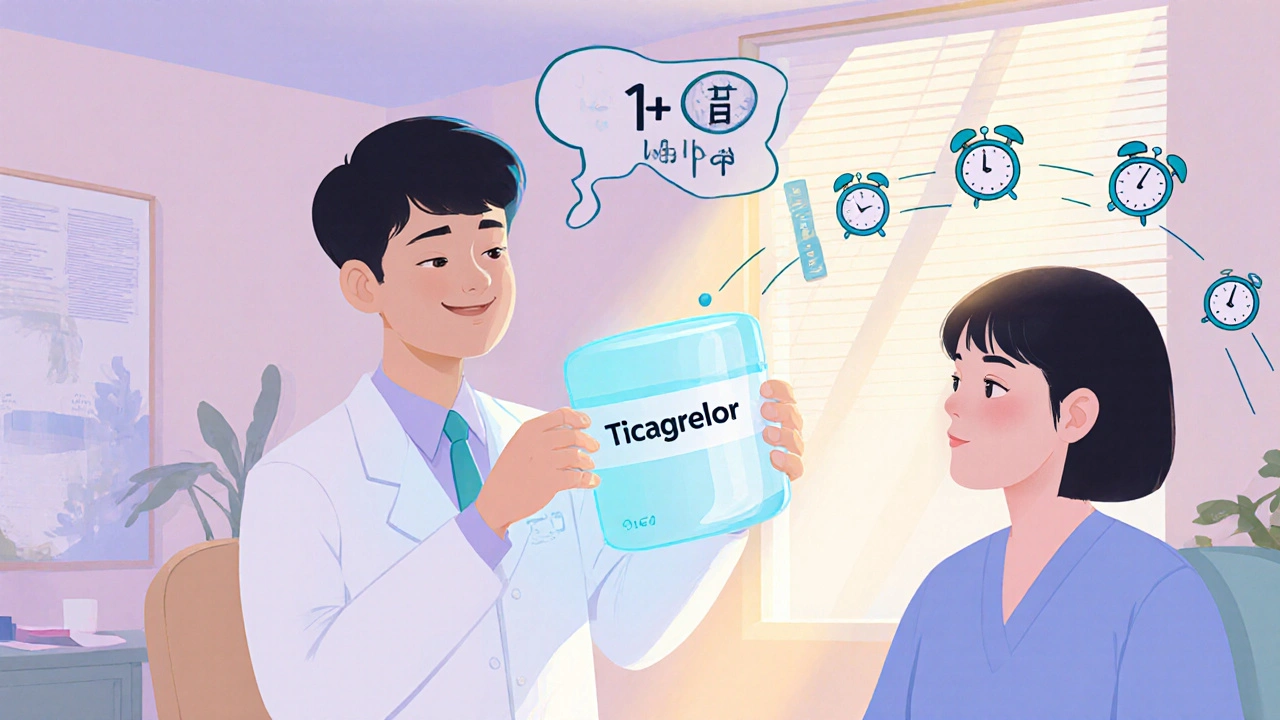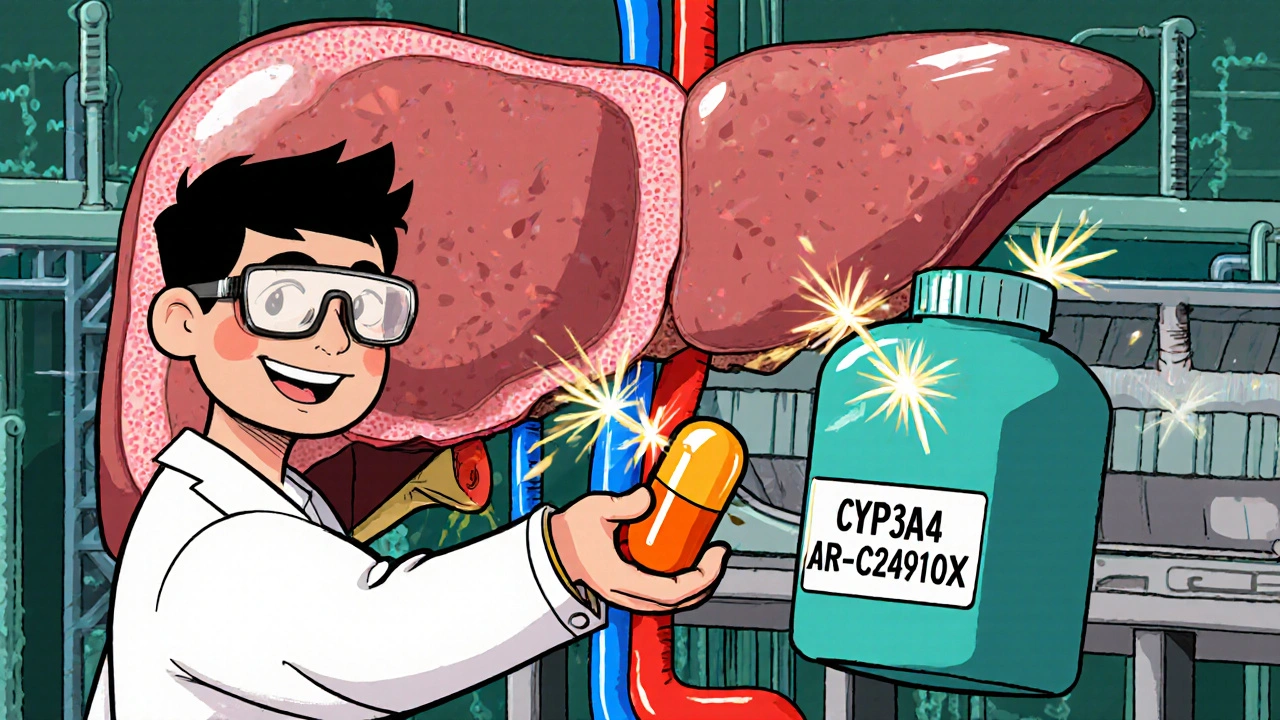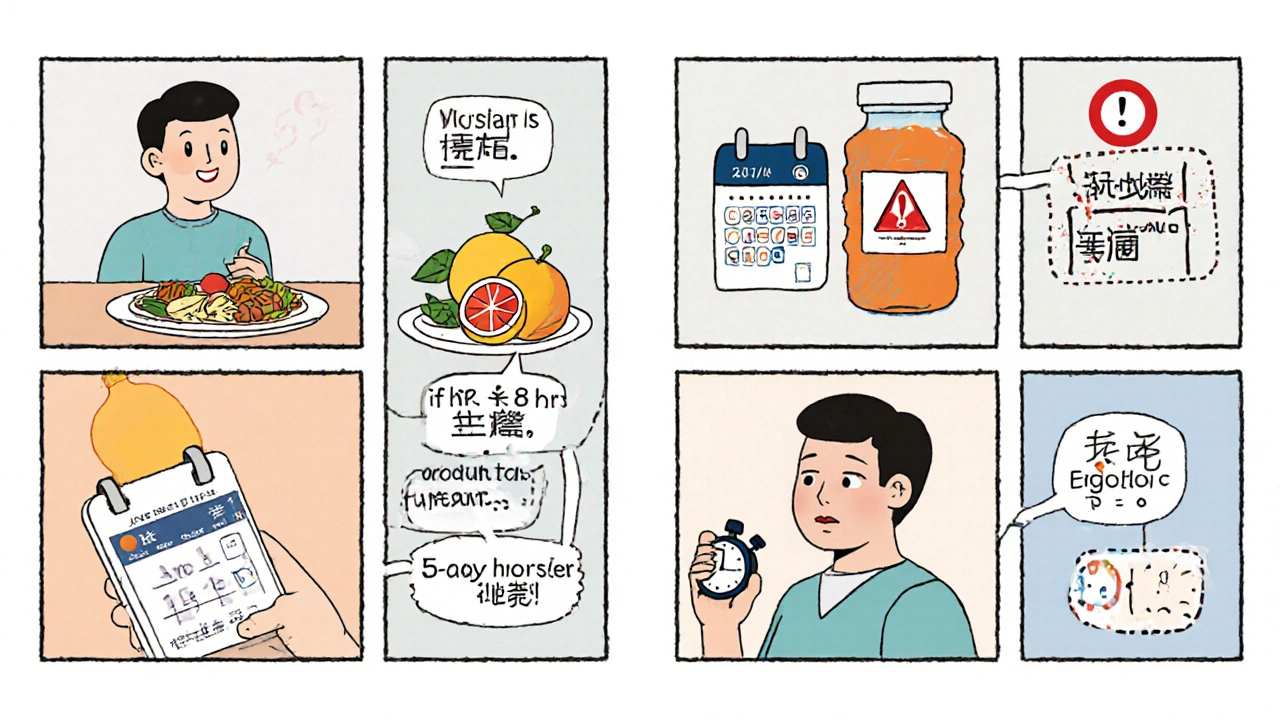Ticagrelor Pharmacokinetics Explained: Absorption, Metabolism & Dosage Insights
 Oct, 22 2025
Oct, 22 2025
Ticagrelor Effect Calculator
Ticagrelor Effect Summary
Results will appear here after calculation
Key Takeaways
- Ticagrelor is absorbed quickly, reaching peak plasma levels in 1‑3 hours.
- It is metabolised mainly by CYP3A4 to an active metabolite (AR‑C124910XX) that shares similar potency.
- The drug’s half‑life is about 7 hours, but the pharmacodynamic effect lasts up to 24 hours.
- Food modestly reduces peak concentration but does not affect overall exposure.
- Compared with clopidogrel, ticagrelor provides faster, more consistent platelet inhibition without needing metabolic activation.
When talking about modern antiplatelet therapy, Ticagrelor is a reversible P2Y12 receptor antagonist that offers rapid and consistent platelet inhibition. Understanding its pharmacokinetic profile helps clinicians decide on dosing, anticipate drug‑drug interactions, and explain what patients might feel after a dose.
What is Ticagrelor?
Ticagrelor (brand name Brilinta) belongs to the thienopyridine class, but unlike clopidogrel it binds directly to the receptor without needing metabolic activation. It blocks the binding of ADP to the P2Y12 receptor, halting the cascade that leads to platelet aggregation. The drug received FDA approval in 2010 after the pivotal PLATO trial demonstrated superior reduction in cardiovascular death, myocardial infarction, and stroke versus clopidogrel.
Pharmacokinetic Basics
Pharmacokinetics describes how the body handles a drug-its absorption, distribution, metabolism, and excretion (ADME). For ticagrelor, each step has practical implications for efficacy and safety.
Absorption
After a standard 180 mg loading dose, ticagrelor reaches its maximum plasma concentration (Cmax) within 1‑3 hours. Oral bioavailability is around 36 % due to first‑pass metabolism. Food can lower Cmax by ~30 % but does not change the area under the curve (AUC), meaning overall exposure stays the same. Therefore, the drug can be taken with or without meals, though clinicians often advise a consistent routine to avoid variability.

Distribution
The drug is about 99 % bound to plasma proteins, mainly albumin. Its apparent volume of distribution is roughly 88 L, indicating extensive tissue penetration, which contributes to the rapid onset of action. Because of high protein binding, displacement interactions are rare, but co‑administration with other highly bound drugs warrants monitoring.
Metabolism
Metabolism is the centerpiece of ticagrelor’s pharmacokinetic story. The enzyme CYP3A4 converts ticagrelor into an active metabolite, AR‑C124910XX. This metabolite retains roughly 80 % of the parent compound’s antiplatelet potency and circulates at similar concentrations. Both parent and metabolite are cleared primarily via the liver; renal excretion accounts for only about 26 % of the administered dose, mostly as unchanged drug.
Elimination
The terminal elimination half‑life of ticagrelor is about 7 hours, while the active metabolite’s half‑life is around 8.5 hours. Despite the relatively short half‑life, the pharmacodynamic effect-platelet inhibition-persists for about 24 hours because of the drug’s high receptor affinity and the combined activity of parent and metabolite. No dose adjustment is required for mild to moderate hepatic impairment, but severe liver disease (Child‑Pugh C) may increase exposure and should be approached cautiously.

Clinical Implications: Dosing and Interactions
Standard maintenance dosing is 90 mg twice daily after the loading dose. Because the effect lasts a full day, missed doses should be taken as soon as remembered unless the next dose is within 8 hours, in which case the missed dose should be skipped to avoid double dosing.
Key drug‑drug interactions stem from CYP3A4 modulation. Strong inhibitors (e.g., ketoconazole, clarithromycin, HIV protease inhibitors) can raise ticagrelor levels by up to 2‑fold, increasing bleeding risk. Conversely, strong inducers (e.g., rifampin, carbamazepine, phenytoin) can halve exposure, potentially reducing efficacy. The FDA label advises dose adjustments or alternative antiplatelet therapy when such agents are unavoidable.
Co‑administration with aspirin is standard in acute coronary syndrome (ACS). The combination does not markedly alter ticagrelor pharmacokinetics, but aspirin heightens bleeding risk, so low‑dose aspirin (75‑100 mg) is preferred.
Comparison with Clopidogrel
While both drugs target the same receptor, their pharmacokinetic pathways differ dramatically. Clopidogrel is a pro‑drug requiring CYP2C19 activation, leading to inter‑patient variability. Ticagrelor’s direct, reversible binding and consistent metabolism via CYP3A4 make its effect more predictable.
| Attribute | Ticagrelor | Clopidogrel |
|---|---|---|
| Onset of Action | 30‑60 minutes | 2‑4 hours |
| Peak Plasma (Cmax) Time | 1‑3 hours | 3‑6 hours |
| Half‑Life | ~7 hours (parent) + 8.5 hours (active metabolite) | ~6 hours (active metabolite) |
| Metabolic Pathway | CYP3A4 → active metabolite (AR‑C124910XX) | CYP2C19 → active thiol metabolite |
| Need for Metabolic Activation | No | Yes |
| Protein Binding | ~99 % | ~98 % |
These differences translate into a more reliable antiplatelet effect for ticagrelor, especially in patients with CYP2C19 loss‑of‑function alleles.
Practical Tips for Clinicians
- Check for strong CYP3A4 inhibitors before prescribing; consider alternative agents if co‑administration is essential.
- Educate patients that the drug can be taken with food, but staying consistent helps avoid fluctuations.
- Monitor for bleeding signs, especially in the first week after the loading dose.
- For patients with severe hepatic impairment, evaluate risk‑benefit carefully; dose reduction is not routinely recommended but close observation is advised.
- In emergency surgery, discontinue ticagrelor at least 5 days prior to reduce bleeding risk, considering its 24‑hour pharmacodynamic window.
Frequently Asked Questions
How long does ticagrelor stay in the body?
The drug’s plasma half‑life is about 7 hours, but platelet inhibition lasts roughly 24 hours because both ticagrelor and its active metabolite bind the P2Y12 receptor.
Can I take ticagrelor with grapefruit juice?
Grapefruit juice inhibits CYP3A4 and can raise ticagrelor levels, increasing bleeding risk. It’s safer to avoid grapefruit products while on ticagrelor.
What should I do if I miss a dose?
If it’s been less than 8 hours since the missed dose, skip it and take the next scheduled dose. If more time has passed, take the missed dose immediately, then continue with the regular schedule.
Is ticagrelor safe for patients on anticoagulants?
Combining ticagrelor with oral anticoagulants (e.g., warfarin, DOACs) markedly raises bleeding risk. Current guidelines recommend using a single antithrombotic strategy unless the clinical scenario mandates dual therapy, in which case close monitoring is essential.
How does ticagrelor differ from aspirin?
Aspirin irreversibly blocks COX‑1, reducing thromboxane A2 production, while ticagrelor reversibly blocks the P2Y12 receptor. Ticagrelor provides stronger platelet inhibition and is preferred in ACS when combined with low‑dose aspirin.
Understanding the ticagrelor pharmacokinetics equips healthcare professionals to tailor therapy, anticipate interactions, and counsel patients effectively. By keeping the ADME profile in mind, clinicians can maximize benefit while minimizing bleeding risk.

Diane Thurman
October 22, 2025 AT 19:46Honestly, most clincians still treat ticagrelor like a magic bullet without even glane at the CYP3A4 interaction list. It's basic pharmaco‑logic-if you ignore the metabolism, you're just courting a bleed.
Sarah Riley
October 28, 2025 AT 18:46Epistemic bias pervades the discourse: ticagrelor's PK is a deterministic vector, not a stochastic anecdote.
Sajeev Menon
November 3, 2025 AT 18:46Let’s break it down so everyone can follow-ticagrelor hits the bloodstream fast, peaking in about 2 hours on average. The CYP3A4 pathway then spins it into the active metabolite, which is alomst as potent as the parent, so you get sustained effect. Remember, food only nudges the Cmax down a bit; the overall exposure stays steady. If you’re worried about bleeding, monitor the patient but don’t skip the dose arbitrarily.
Emma Parker
November 9, 2025 AT 18:46Hey, I just wanted to pop in and say I’ve been sipping grapefruit juice while on ticagrelor-big mistake! It really ramps up the levels, so if you love your morning OJ, maybe stick to plain water.
Joe Waldron
November 15, 2025 AT 18:46Ticagrelor’s pharmacokinetics are straightforward, yet they demand attention; absorption is rapid, distribution is extensive, metabolism is via CYP3A4, and elimination is relatively quick!!! This means you get a predictable antiplatelet effect, but you also have to watch for strong enzyme inhibitors-especially azole antifungals.
Wade Grindle
November 21, 2025 AT 18:46From a pharmacological perspective, ticagrelor demonstrates a high degree of protein binding and a balanced elimination profile, which together support its twice‑daily dosing schedule.
Sameer Khan
November 27, 2025 AT 18:46The pharmacokinetic profile of ticagrelor epitomizes the convergence of molecular pharmacology and clinical pragmatism. Its rapid absorption, achieving peak plasma concentrations within a narrow 1‑3 hour window, aligns with the exigencies of acute coronary syndrome management. The extensive protein binding of approximately 99 % confers a reservoir effect that stabilizes plasma levels despite inter‑individual variability. Metabolism via CYP3A4 generates the active metabolite AR‑C124910XX, which retains near‑equivalent antiplatelet potency. This biotransformation obviates the need for pro‑drug activation, thereby mitigating the genetic polymorphisms that compromise clopidogrel efficacy. The half‑life of the parent compound, roughly seven hours, is complemented by an eight‑and‑a‑half hour half‑life of the metabolite, collectively sustaining receptor occupancy. Consequently, platelet inhibition persists for approximately twenty‑four hours, justifying a twice‑daily dosing regimen. Interactions with strong CYP3A4 inhibitors, such as ketoconazole, can amplify systemic exposure, underscoring the necessity for vigilant drug‑drug interaction assessment. Conversely, inducers like rifampin may halve the effective concentration, potentially jeopardising therapeutic outcomes. The clinical imperative, therefore, is to balance efficacy with safety by individualising therapy in the context of concomitant medications. While food modestly attenuates Cmax, the overall area under the curve remains unaltered, permitting flexible dosing relative to meals. In patients with severe hepatic dysfunction, the augmented exposure mandates close monitoring, albeit dose reduction is not standardised. Pre‑operative management should incorporate a minimum five‑day discontinuation interval to mitigate surgical bleeding risk. The comparative superiority of ticagrelor over clopidogrel, particularly in carriers of CYP2C19 loss‑of‑function alleles, is substantiated by robust outcome data. Ultimately, a nuanced appreciation of these pharmacokinetic intricacies empowers clinicians to optimise antiplatelet therapy while minimising adverse events.
Kiara Gerardino
December 3, 2025 AT 18:46It is utterly unacceptable that anyone would dismiss the bleeding risk of ticagrelor as merely a footnote; patient safety must reign supreme above all pharmaceutical hype.
Tim Blümel
December 9, 2025 AT 18:46Understanding the PK of ticagrelor is like unlocking a puzzle 🧩; once you see how the CYP3A4 cascade works, you can guide patients with confidence 😊.
Michael Vandiver
December 15, 2025 AT 18:46Totally agree with the point about food not changing exposure 🍽️ it just smoothes the peak so you can stick to your routine 😎
Suryadevan Vasu
December 21, 2025 AT 18:46Grapefruit and ticagrelor do not mix.